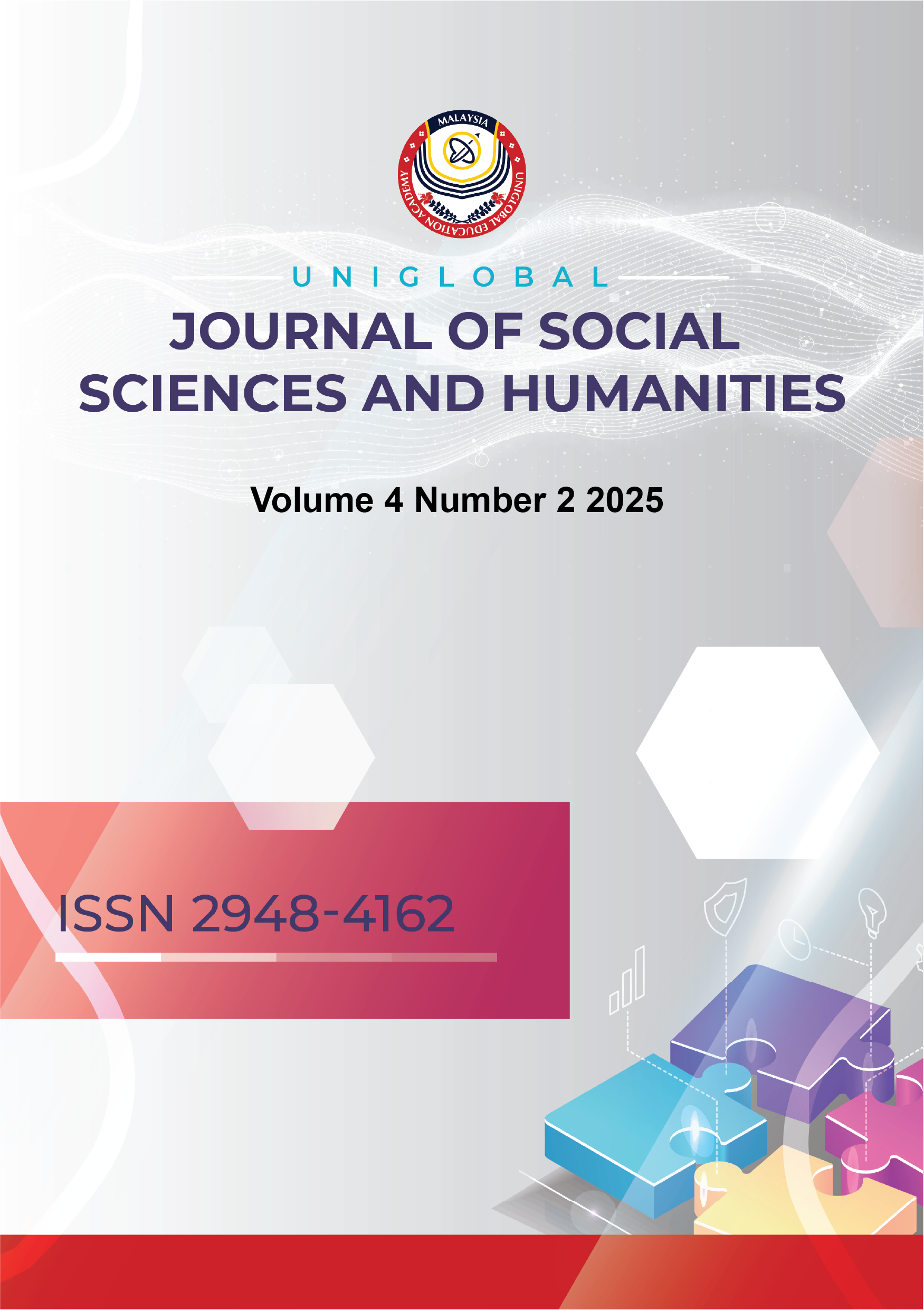The Impact of Industry Revolution 4.0 Technologies and Education 4.0 on PE Learning Outcomes among University Students in Heilongjiang, China
DOI:
https://doi.org/10.53797/ujssh.v4i2.11.2025%20Keywords:
Industry revolution 4.0, education 4.0, physical education, digital transformation, educational technologyAbstract
Digital transformation, driven by Industry Revolution 4.0 (IR 4.0) and Education 4.0 (Ed 4.0), is significantly reshaping education, particularly practical subjects like Physical Education (PE). A study investigating this impact on PE learning outcomes among 449 university students in Heilongjiang, China, utilized a quantitative cross-sectional design with Structural Equation Modeling (SEM). The research examined the relationships between five key technological factors Virtual Reality (VR), Augmented Reality (AR), Internet of Things (IoT), Big Data analytics, and Cloud Computing and PE learning outcomes. All constructs demonstrated high reliability (Cronbach's alpha > 0.90). The findings revealed remarkably strong positive relationships between all technological factors and PE learning outcomes. Cloud Computing exhibited the strongest impact (β = 0.996, p < .001), followed by IoT (β = 0.946, p < .001), Big Data (β = 0.937, p < .001), AR (β = 0.935, p < .001), and VR (β = 0.934, p < .001). Strong intercorrelations among these factors suggest synergistic benefits when implemented together. This study confirms that comprehensive digital transformation strategies employing multiple complementary technologies are more effective than isolated approaches, offering evidence-based guidance for institutions and policymakers to invest in robust technological infrastructure, especially cloud computing, to enhance PE education.
References
Ahmad, I., Sharma, S., Singh, R., Gehlot, A., Lovi Raj Gupta, Amit Kumar Thakur, Neeraj Priyadarshi, & Bhekisipho Twala. (2024). Inclusive learning using industry 4.0 technologies: addressing student diversity in modern education. Cogent Education, 11(1). https://doi.org/10.1080/2331186x.2024.2330235
Benavides, L. M. C., Tamayo Arias, J. A., Arango Serna, M. D., Branch Bedoya, J. W., & Burgos, D. (2020). Digital Transformation in Higher Education Institutions: A Systematic Literature Review. Sensors, 20(11), 3291. https://doi.org/10.3390/s20113291
Bores-García, D., Hortigüela-Alcalá, D., Fernandez-Rio, F. J., González-Calvo, G., & Barba-Martín, R. (2021). Research on cooperative learning in physical education: Systematic review of the last five years. Research quarterly for exercise and sport, 92(1), 146-155.
Bujang, S. D. A., Selamat, A., Krejcar, O., Maresova, P., & Nguyen, N. T. (2020, April). Digital learning demand for future education 4.0—Case studies at Malaysia education institutions. In Informatics (Vol. 7, No. 2, p. 13). MDPI. https://doi.org/10.3390/informatics7020013
Butt, R., Siddiqui, H., Soomro, R. A., & Asad, M. M. (2020). Integration of Industrial Revolution 4.0 and IOTs in academia: a state-of-the-art review on the concept of Education 4.0 in Pakistan. Interactive Technology and Smart Education, 17(4), 337-354. https://doi.org/10.1108/itse-02-2020-0022
Chanthiran, M., Ibrahim, A. B., Rahman, M. H. A., Kumar, S., & Dandage, R. V. (2022). A Systematic Literature Review with Bibliometric Meta-Analysis of AI Technology Adoption in Education. EDUCATUM Journal of Science, Mathematics and Technology, 9, 61–71. https://doi.org/10.37134/ejsmt.vol9.sp.7.2022
Cojocaru, A. M., Bucea-Manea-Țoniș, R., Jianu, A., Dumangiu, M. A., Alexandrescu, L. U., & Cojocaru, M. (2022). The role of physical education and sports in modern society supported by IoT—a student perspective. Sustainability, 14(9), 5624.. https://doi.org/10.3390/su14095624
Costa, A. C. F., de Mello Santos, V. H., & de OLIVEIRA, O. J. (2022). Towards the revolution and democratization of education: a framework to overcome challenges and explore opportunities through Industry 4.0. Informatics in Education, 21(1), 1-32. https://doi.org/10.15388/infedu.2022.01
Vonitsanos, G., Moustaka, I., Doukakis, S., & Mylonas, P. (2024, May). Transforming Education in the Digital Age: Exploring the Dimensions of Education 4.0. In 2024 IEEE Global Engineering Education Conference (EDUCON) (pp. 01-10). IEEE. https://doi.org/10.1109/educon60312.2024.10578747
González-Pérez, L. I., & Ramírez-Montoya, M. S. (2022). Components of Education 4.0 in 21st century skills frameworks: systematic review. Sustainability, 14(3), 1493. https://doi.org/10.3390/su14031493
Jain, M., Soni, G., Mangla, S. K., Verma, D., Toshniwal, V. P., & Ramtiyal, B. (2025). Mediating and moderating role of socioeconomic and technological factors in assessing farmers attitude towards adoption of Industry 4.0 technology. British Food Journal, 127(5), 1810-1830. https://doi.org/10.1108/bfj-12-2023-1139
Wicagsono, M. A., & Al, B. M. A. M. H. (2023). Strategies for Improving Teacher Pedagogic Competence Industrial Revolution Era 4.0. Multicultural Islamic Education Review, 1(1), 15-25. https://doi.org/10.23917/mier.v1i1.2816
Qureshi, A. H., Alaloul, W. S., Manzoor, B., Musarat, M. A., Saad, S., & Ammad, S. (2020, November). Implications of machine learning integrated technologies for construction progress detection under industry 4.0 (IR 4.0). In 2020 Second International Sustainability and Resilience Conference: Technology and Innovation in Building Designs (51154) (pp. 1-6). IEEE. https://doi.org/10.1109/ieeeconf51154.2020.9319974
Teo, T., Unwin, S., Scherer, R., & Gardiner, V. (2021). Initial teacher training for twenty-first century skills in the Fourth Industrial Revolution (IR 4.0): A scoping review. Computers & Education, 170, 104223. https://doi.org/10.1016/j.compedu.2021.104223
Downloads
Published
How to Cite
Issue
Section
License
Copyright (c) 2025 Xiaowei Han

This work is licensed under a Creative Commons Attribution-NonCommercial-ShareAlike 4.0 International License.



